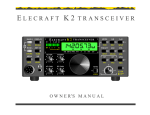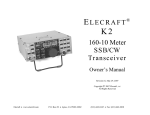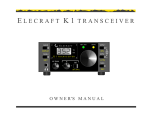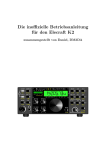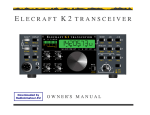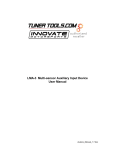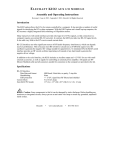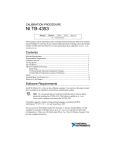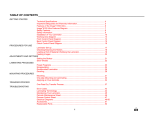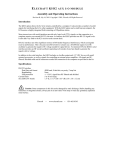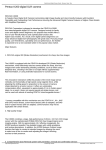Download K2 Revision Revision 2 Installation and Description
Transcript
ELECRAFT K 2 REVISION 2 FIRMWARE Installation and Reference Manual Rev. B, August 28, 2001 Summary of Changes................................................................................................................................................ 2 Computer Control (KIO2)..................................................................................................................................... 2 Transverter Bands ................................................................................................................................................. 2 RTTY/Data Mode and Fine RIT........................................................................................................................... 2 "Fast Play" CW Message Buffers ......................................................................................................................... 2 More Accurate VFO Calibration .......................................................................................................................... 2 Other New Operating Features ............................................................................................................................. 2 Firmware Installation ................................................................................................................................................ 3 VFO Calibration........................................................................................................................................................ 4 Primary and Secondary Menus ................................................................................................................................. 5 Additional Edit-mode Options.............................................................................................................................. 5 Programmable Function Buttons (PF1, PF2)........................................................................................................ 5 Secondary Menu Functions....................................................................................................................................... 6 Squelch (SLCH).................................................................................................................................................... 6 Tuning Rate Selection (RATES) .......................................................................................................................... 6 Keying Weight (DOT) .......................................................................................................................................... 6 Fast-Play CW Messages (FPLY) .......................................................................................................................... 6 RS232 Interface Setup (PORT) ............................................................................................................................ 6 SPLIT/RIT/XIT Configuration (SPLT) ................................................................................................................ 6 10 and 12 Meter Power Limit in SSB/RTTY Modes (Po28)................................................................................ 6 RTTY/Data Mode (RTTY) ................................................................................................................................... 7 FINE RIT .............................................................................................................................................................. 7 Real-Time Clock (RTC) ....................................................................................................................................... 8 RIT/XIT Range Selection (RIT) ........................................................................................................................... 8 Accessory Outputs (ACC) .................................................................................................................................... 8 KPA100 Mode (PA) ............................................................................................................................................. 8 Transverter Bands (TRN1/TRN2/TRN3) ............................................................................................................. 9 Other Changes......................................................................................................................................................... 10 FINE RIT ............................................................................................................................................................ 10 SSB Operation .................................................................................................................................................... 10 CW Operation ..................................................................................................................................................... 10 Filter Status (XFIL and AFIL)............................................................................................................................ 10 Calibration Functions.......................................................................................................................................... 10 ATU Control ....................................................................................................................................................... 10 1 Summary of Changes Revision 2 is a major upgrade to the K2 firmware, with many new features and improvements. These changes are summarized below. All of the new features are accessed from a secondary menu, allowing you to decide which features to use. The original configuration menu and basic K2 operation remains unchanged. Computer Control (KIO2) Support for the KIO2 Aux. I/O option, providing full control of the K2 via RS-232. Great for contesting, logging, and remote control--even over the Internet. Transverter Bands Up to three bands for use with transverters, each independently programmable. Frequency is displayed directly up to 999999.00 MHz. Includes four choices for I.F. bands; transverter oscillator correction (+/9.99 kHz), and fixed or variable power control, all on a per-band basis. Transverter relay switching in CW mode can be controlled using the 8 volt receive line (8R), thanks to a new "8R Hold" mode, which keeps this line low during the T - R delay. The KIO2 option brings this and other lines to a rear-panel connector. RTTY/Data Mode and Fine RIT User-selectable RTTY/Data mode with four independent crystal filters. Also includes a new FINE RIT feature for use with narrow-band data modes (e.g., PSK31) where RX/TX shift has to be minimized. Allows you to match one wide and one narrow filter to within about 3 to 5 Hz (typical). "Fast Play" CW Message Buffers Fast Play (one-button) CW message playback using your choice of four different switch groups. CW message buffers are also larger--250 bytes each--and message record timing is much more accurate. Keying weight is now adjustable, over a range of approx. 90-140% of the original weighting. More Accurate VFO Calibration VFO dial calibration is now much more accurate across the entire tuning range of the K2, typically +/- 20 Hz. Just one C A L P L L pass now aligns the VFO on all bands. Other New Operating Features § § § § § § Four RIT/XIT ranges--up to +/- 4.8 kHz Independent or per-band storage of S P L IT , R IT , and X I T configuration Four different configurations for the R A T E switch (VFO tuning rate) Squelch (OFF or adjustable level, 1-10) Sideband Reverse: holding C W R V alternates between LSB and USB "8R Hold" setting minimizes external amplifier and transverter relay switching in CW mode 2 Firmware Installation If you obtained this firmware as an upgrade, you'll need to replace the old microcontroller with the new one as explained below. None of your existing configuration settings or memories will be lost. 1. Turn the K2 off and remove the top cover. The six screws to be removed are shown below. 1 2 4 3 5 6 i CAUTION: To prevent possible damage to components, touch an unpainted, grounded metal surface frequently while handling PC boards or ICs. 2. Take out the two screws that hold the control board to the front panel. Remove the control board using the long-handled Allen wrench (supplied with the K2). 3. Carefully remove the old microprocessor, U6 (control board), using a small screwdriver to pry it gently out of its socket at both ends. Store U6 in a safe place as a backup. 4. Straighten the leads of the new microcontroller (PIC18C452) as shown below. The two rows of pins must be straight and parallel to each other to establish the proper pin spacing. To straighten the pins, rest one entire row of pins against a hard, flat surface. Press down gently on the other row of pins and rock the IC forward to bend the pins into position. Then flip the IC end-for-end and repeat this technique to straighten the other row. Flared Straight 3 5. Install the new microcontroller, being careful not to bend any pins. Orient the notched or dimpled end of the IC with the notched end of its component outline. 6. Plug in the control board and secure it to the front panel. 7. Turn on the K2 and make sure that you see the E L EC R A F T message. Tapping any switch during this message will show the new main microcontroller firmware revision (2 . 0 1 or higher) on the left end of the display. The number on the right is the I/O Controller firmware revision, which will not change. 8. This version of the firmware provides more accurate VFO dial calibration. You must perform the new onepass CAL PLL calibration step described in the next section, or your VFO will not tune correctly. VFO Calibration This revision of the K2 firmware uses a completely new VFO calibration technique. After calibration, the dial will read much more accurately across the entire tuning range of the K2, both inside and outside of the amateur bands. This new procedure is done only on 40 meters--it does not have to be repeated on each band. Allow the K2 to warm up at normal operating room temperature for at least five minutes. Plug the K2 frequency counter cable into the control board. Connect the probe end to test point TP1 (VCO). Switch to 40 meters. You do not need to set the VFO to a specific frequency; it can be anywhere in the band. Tap M EN U and locate the C A L entry (using B A N D + / B A N D - or by turning the VFO knob). Hold E D IT , then change the parameter to P L L. 5. Hold E D IT again to begin the calibration procedure. You'll see a frequency in the 12 MHz range displayed, and the letter "d" will flash as the firmware records calibration data. After approximately five minutes, you'll hear a short tone, and E N D will be displayed. Tap any switch to clear this message. 1. 2. 3. 4. i If you see I N F O 2 3 2 at any time during VFO calibration, tap any switch to clear the message, then verify that you were on 40 meters and that the counter cable was plugged into TP1. If you still get I N F O 2 3 2 with the correct setup, it's likely that your counter probe is malfunctioning or is plugged in backwards at the control board. 6. Optional VFO Accuracy Check: You may wish to check the VFO's accuracy by tuning in a signal at a known frequency, such as WWV (at 10, 15, or 20 MHz). If the VFO is off by more than about 20-30 Hz, you can make an adjustment to the 4 MHz oscillator on the Control board, then re-do both CAL PLL and CAL FIL to correct the reading error. This procedure is described in the K2 Owner's Manual, page 98 (Using a Calibrated Signal Source). Note: Steps 8 and 11 of the procedure on page 98 are incorrect for the new firmware. CAL PLL is run only one time, and only on 40 meters. 7. Move the K2 counter cable to the BFO test point, TP2 (or remove the cable and store it). 8. Re-install the top cover. 4 Primary and Secondary Menus If you tap M EN U you'll see the K2's original set of menu entries. This is now referred to as the primary menu. To access the secondary menu, where controls for many of the new features can be found, tap D IS P L A Y (after tapping M EN U). As you go back and forth between the two menus with D IS P L A Y, you'll see P R I and S EC . All menu entries are listed below. For further details on the primary menu entries, see the K2 Owner's Manual, page 83. Secondary menu entries are described in detail in the next section. Items marked with an asterisk (*) are accessed with D IS P L A Y, as explained below. Primary ST L ST P T-R R PT IN P IA B SSB A SSB C LCD G R PH OPT ATU RANT CAL PF 1 / PF 2 Secondary Sidetone level, *TONE pin Sidetone pitch QSK delay, *8R mode Auto-repeat delay Keying device, *Auto-detect Iambic keying mode Mic gain Compression level Backlight control Bargraph mode Optimization (batt/perf.) ATU mode RX antenna selection Calibration menu Programmable Functions SL C H R A T ES D OT F PL Y POR T SPL T P o 28 RTTY RTC R IT ACC AT2 PA T R N 1- 3 (pg. 6) (pg. 6) (pg. 6) (pg. 6) (pg. 6) (pg. 6) (pg. 6) (pg. 7) (pg. 8) (pg. 8) (pg. 8) -(pg. 8) (pg. 9) Squelch level R A T E switch selections Dot/space ratio (keying weight) Fast Play switch selections RS232 interface on/off, *Port Test S P L IT , R IT , X I T configuration 10 / 12 meter SSB power output limit RTTY (data) mode control Real-time clock control RIT/XIT offset range (up to +/- 4.8 kHz) Accessory output control Reserved for control of external ATU KPA100 option mode selection Transverter band setup (*Parameter) * Additional Edit-mode Options The following menu entries provide extended options in edit mode. These are selected by tapping D IS P L A Y. Menu Entry D IS P L A Y Function ST L T-R Selects the sidetone source, U 6- 25 or U 8- 4. Use U 8 - 4 with the KIO2 (see KIO2 manual) Specifies 8-volt receive signal behavior, 8 r n o r or 8 r h o ld . "Hold" mode is intended for use with external amplifiers or transverters: in CW mode, it holds the 8V rcv line low for the duration of the QSK delay. 8 r h o ld mode can be used at all times, even if you don't use an external amplifier or transverters, and will not affect performance in any way. Selects auto-detect mode, A D ET O n or A D ET O f f. If you plan to connect both a keyer and hand-key to the K2's KEY jack, use A D ET O n . Sends an "FA" (VFO A frequency) response to the computer if P O R T is set to O n . Cycles through the five transverter parameters (on/off, RF, IF, offset, power level). IN P POR T T R N 1- 3 Programmable Function Buttons (PF1, PF2) P F 1 and P F 2 can be assigned to any entry in either menu, or to S C A N or F Po n (Fast-Play on/off). First, select P F 1 or P F 2 in the menu, then E D IT the parameter. To switch to the secondary menu entries, tap D IS P L A Y. Tapping D IS P L A Y again will return to the primary menu entries. Note: The S C A N and F Po n parameters for PF1/PF2 are located in the primary menu. The original R IT 1/ 2 option for PF1/PF2 has been removed. However, you can assign PF1 or PF2 to the new RIT/XIT offset range menu entry (R IT ) as an alternative. 5 Secondary Menu Functions Squelch (SLCH) Squelch holds the receiver muted until a signal is present; it defaults to O F F. You can set the level to 1 -1 0 , corresponding to the S-meter's bargraph segments. A signal that is stronger than the selected level will open squelch for a minimum of 4 seconds. Transmitting holds it open for about 10 seconds. Tuning Rate Selection (RATES) This R A T ES menu entry lets you specify how the R A T E button works. The four options are: 3N 3R 3C 2 three VFO tuning rates, normal order (10/50/1000 Hz steps) three VFO tuning rates, reverse order (1000/50/10 Hz steps) three VFO tuning rates, optimized for CW/Contest use (10/20/1000 Hz steps) two VFO tuning rates (10/50 Hz steps only) Keying Weight (DOT) D OT sets the internal keyer's dot/space ratio (keying weight). The range is 0 . 9 0 -1 . 4 0 , roughly 90% to 140% of "normal" weighting. The default is 1 . 1 0 . Most operators will find something between 1 . 0 0 -1 . 2 0 to be about right. Weighting only applies to speeds up to about 40 WPM. Fast-Play CW Messages (FPLY) Normally, CW messages are played by first tapping M SG , then the number of the message buffer to be played (0 -8 ). This two-switch sequence is fine for most casual operation and light contesting. For serious contesting, some operators prefer to have one-touch access to messages, which we refer to as Fast-Play. To use Fast-Play: Use the menu to program P F 1 or P F 2 as F Po n. This allows you to quickly turn Fast-Play mode on or off. Next, use the F PL Y menu entry to select one of four switch groups (4 5 , 4 5 8 , 2 3 , or 2 - 5). For example, if you have 2 - 5 selected, you can use the switches labeled 2 , 3 , 4 , and 5 for Fast-Play. Which switch group to use depends on how many Fast-Play switches you need, and which regular switch T A P functions you use least while in CW mode. (The regular H O L D function of each switch is unaffected.) When Fast-Play is on, the letter F will replace the mode letter c once every few seconds as a reminder. A tap of any Fast-Play switch will play its message buffer one time; to auto-repeat, you must still use M SG as described in the K2 manual. RS232 Interface Setup (PORT) If you install the KIO2 Aux. I/O option, you'll need to use the P OR T menu entry to turn on 4800-baud RS232 communication. A computer can then be used with the K2 for logging, contesting, or general remote-control. Refer to the KIO2 manual for details. SPLIT/RIT/XIT Configuration (SPLT) Normally, the K2's S P L IT , R IT , and X I T selections stay the same as you switch from one band to the next, and all three are turned off when you first turn the K2 on. This is the case if you leave the S P L T menu entry at its default setting (N OR ). If you prefer to have these selections stored on a per-band basis and retained when power is off, set S P L T to P E R (per-band). 10 and 12 Meter Power Limit in SSB/RTTY Modes (Po28) The K2 is typically capable of 12-15 watts output on the highest two bands in CW mode with a 14V supply. However, the highest distortion-free single-sideband output level may be lower, especially when running from 12V. Unless you have done on-air testing at a higher level, we recommend leaving the P o 28 menu entry at 1 0 . 0 watts to avoid transmitting a distorted signal. This power limit will affect only SSB and RTTY modes. When you turn the POWER pot with a limit set, the pot's range will reflect the limit. 6 RTTY/Data Mode (RTTY) To better accommodate data communications such as PSK31, RTTY, etc., we've provided a new RTTY/Data mode (mode letter lower-case r ). This mode gives you four independent crystal filter settings, sideband selection, and a separate speech compression setting. The FINE RIT feature is also useful for data modes (see below). To enable RTTY/Data mode: set the R T T Y menu parameter to O N and exit the menu. The M OD E switch will then cycle through all four modes (C , L , U , and r ). r -NORMAL mode uses lower sideband, and r -REVERSE (with a "bar" over the r ) uses upper sideband. To select r -REVERSE, hold the C W R V switch. Filter configuration (C A L F IL ): When you first turn on r mode, its four filters will use the same settings as your present LSB and USB filters. Use C A L F IL to modify the r -mode filter bandwidths or BFO settings as needed. Do this on 18 MHz or lower to avoid confusion due to sideband inversion on the higher bands. Speech compression setting (S S B C r): The S S B C menu entry will change to S S B C r when r mode is selected. A setting of 1 - 1 (1:1, or speech compression off) is recommended in most cases for RTTY/data. FINE RIT FINE RIT can be used with data communications modes to reduce the T/R shift between FL1 and one other filter1. It is only effective for this purpose if FL1 is configured as O P 1 (SSB crystal filter). FINE RIT can also be used to more accurately zero-beat AM broadcast stations, or fine-tune CW signals when a very narrow crystal or audio filter is used. When FINE RIT is ON, the RIT and XIT annunciators will alternate on/off slowly as a reminder. Note: Entering FINE RIT mode disables S P L IT , R IT , and X I T . Conversely, turning on S PL IT , R IT , or X I T disables FINE RIT mode, as does turning off the K2, or changing bands, modes or VFOs. Also, since the fine adjustment resolution is finer than the VFO's normal 10 Hz resolution, you may need to re-adjust the offset if you move the VFO knob. To use FINE RIT with data modes: Select a narrow data-mode filter (F L 2 - F L 4) using X F IL . Next, hold R IT and X F IL together; the display will show F IN E O N . Only F L 1 and the selected narrow filter will now be available; the other two will be temporarily disabled. You can then use the RIT/XIT offset knob to fine-adjust the signal pitch of the narrow filter without affecting the pitch with FL1. When you transmit (always through OP1) you will now be closer to the received station's carrier frequency, and on receive, switching filters will result in few if any lost characters. To cancel FINE RIT mode, hold R IT + X F IL . Turning the offset knob will display the FINE RIT offset, from -15 to +15 "units" (e.g., F L 3 - 12 ). One unit is about 3 to 6 Hz (finer on lower bands). Turning OFFSET with F L 1 selected will always show F L 1 0 0 because FINE RIT only applies to F L 2-F L 4. To fine-tune AM broadcast stations: Make sure that F L 2 is optimized for receive (see SSB adapter manual). Select F L 2 using X F IL , and turn on FINE RIT by holding R IT and X F IL together. The RIT/XIT knob can then be used to accurately zero-beat the carrier, making voice or music sound more natural. To fine-tune CW signals: Select a narrow filter using X F IL (F L 2 - F L 4). Turn on FINE RIT by holding R IT and X F IL together. The RIT/XIT knob can then be used to fine-adjust the signal pitch. Tapping X F IL will switch between F L 1 and the narrow filter. FINE RIT is especially useful with the KAF2's narrow audio filter settings. 1 When using data modes, the transmit and receive frequency will always be exactly the same if you use only FL1 (set for the SSB option crystal filter, O P 1), and avoid using splits. However, you may wish to switch to a narrow filter when QRM is present. The small resulting shift in frequency between O P1 (which is used on transmit) and the narrow filter can cause the signal to "walk" up or down the band if "net" is turned on in the demodulation software. Most software provides a means of turning off "net" (i.e. locking the TX frequency), which is the best alternative in many cases. 7 Real-Time Clock (RTC) If the KAF2 audio filter/RTC option is installed, the K2 can display 24-hour time, or the date, when the D IS P L A Y button is tapped. This may eliminate the need for a separate clock during field operation. The RTC includes its own long-life backup battery. To use the RTC: Set the R T C menu entry to O N , then exit the menu. Tapping D IS P L A Y will show the time, e.g. 1 8. 3 0 . 2 4 . Holding B A N D + / B A N D - together will switch to date display. A second tap of D IS P L A Y shows the voltage/current readings, and a third tap returns you to the frequency display. Moving the VFO knob or transmitting will also restore the frequency display, as will pressing any switch except , B A N D + / B A N D -, To set the time and date: A specific time/date setting sequence is used to prevent accidental changes. Refer to the KAF2 option manual for details. RIT/XIT Range Selection (RIT) The R I T menu entry lets you specify the OFFSET control range, which affects both R IT and X I T . The options are +/- 0 . 6 , 1 . 2 , 2 . 4 , and 4 .8 kHz. Offset knob tuning resolution is decreased for the highest two ranges, to 20 Hz and 40 Hz per step respectively. Note: Older K2 firmware allowed you to assign P F 1 or P F 2 to R IT 1/ 2 as a means of alternating between two fixed RIT ranges. Instead, you can assign P F 1 or P F 2 to the R IT menu entry. The RIT and XIT annunciators will flash (when turned on) if the offset range selected is higher than +/- 0.6 kHz. This allows you to tell at a glance whether you have the smallest offset range or a wider offset range selected. Accessory Outputs (ACC) This menu entry is used with an external Elecraft AuxBus decoder called the AuxBox2 that provides user-definable I/O lines, 12 decoded per-band outputs, an output based on the R A N T menu selection, and one based on A N T 1/ 2 . These outputs are ideal for selecting antennas, filters, transverters, etc. The 3 user-definable I/O lines are configured using the A C C menu entry (details will be provided in the AuxBox user manual). KPA100 Mode (PA) If the KPA100 option is installed, its present operating mode will appear in the P A menu entry. If you then select P A O N , the POWER control and power displays will use watts rather than tenths of a watt. For further information, refer to the KPA100 instruction manual. 2 Future option. 8 Transverter Bands (TRN1/TRN2/TRN3) Up to three user-definable bands are provided for use with transverters. Each transverter's frequency and its associated K2 band (the I.F.) can be specified. Also provided is a per-band +/- 9.99 kHz offset to compensate for errors in oscillator chains, as well as per-band power settings. The LCD can show transverter frequencies up to 999 MHz directly. The transverter frequency can even be below its I.F. band, providing for VLF transverters. Transverter band setup: Five parameters can be set up independently on each band (T R N 1- 3): ON / OF F RF IF OF S OU T Set to ON to have this transverter band accessible with B A N D + / B A N D Transverter operating frequency (0-999 MHz; GHz digits not used) K2 band to use as the I.F. (7, 14, 21, or 28 MHz) Display offset (+/- 9.99 kHz); calibrate based on transverter oscillator offset, if any Power output (set to P OT to use the POWER pot, or set fixed level, 1 . 0 -1 5 . 0 watts). When you scroll to one of the T R N x menu entries, you'll see the O N / O F F parameter. Tap D IS P L A Y to rotate through the other parameters. Changes to transverter setups will take effect when you exit EDIT mode. Power output level: The minimum fixed power level provided in the T R N menu entry is 1.0 watts because this is the lowest level that can be obtained in SSB mode. 0.1W or less is possible in CW mode, but since both CW and SSB will be used, the SSB minimum was chosen to avoid accidental transverter overdrive when changing modes. When you use T U N E on a transverter band, the power output used is the one specified in the associated T R N menu entry, unless you selected P O T , in which case the POWER potentiometer setting will be used. Selecting transverter bands: When you switch to a transverter band (using B A N D + / B A N D -), the message T R N 1, 2 o r 3 is flashed as a reminder. The transverters themselves must be switched in and out manually. Transverter frequency display: The LCD shows frequencies up to 999 MHz by shifting one place to the right, except when the 10-Hz tuning rate is in use. In the 10-Hz case, the hundreds of MHz digit is not displayed. Controlling transverter relay switching in CW mode: Many transverters use relays for T-R switching, which can be annoying during CW operation. To control relay switching, you can use the K2's "8R" (8-volt RX) signal, which is available at the KIO2 Aux I/O connector. Simple external hardware can be used to switch transverters to TX mode when 8R goes from 8V to 0V. The firmware also provides a way to keep 8R at 0V during the T-R delay. (This has no effect on normal operation of the K2.) To use this "8R hold" feature, locate the T - R menu entry, set the delay parameter to the desired value, then tap D IS P L A Y until 8 r h o ld is displayed. Direct Frequency Entry is supported on transverter bands, but is in-band only, and +/- 2 MHz from the userdefined RF band edge. You must supply 5 digits. For bands over 99 MHz, the first digit is made part of the prompt. For example, on a transverter band in the 430 MHz range, you'd see - - - - 4 when you hold B A N D + and B A N D - together to initiate Direct Frequency Entry. To get to 432.100 MHz, you'd then enter 3 2 1 0 0 . ATU considerations: With a KAT2 installed, the K2 will recall the last antenna selected for each transverter band, so you could use one antenna jack for transverters and the other for HF antennas, assuming that the isolation between the antenna jacks is sufficient for the planned operation. (This should be verified.) You can use the tuner to provide a 1:1 match when transmitting into the transverter RF input, or manually put the ATU into C A L P or C A L S mode when you switch to a transverter band. In the latter case, all L and C values will be set to zero. Use caution when connecting both a transverter and an HF antenna to the KAT2: you could accidentally transmit at high power into the transverter. For example, suppose that you have TRN1 set up for an I.F. of 14 MHz and a 1.0-watt power limit. If you switch the K2 to 14 MHz--where there is no power limit--you must remember not to transmit into the KAT2 antenna jack that is connected to the transverter. 9 Other Changes FINE RIT FINE RIT can be used for fine-tuning data, CW, or commercial broadcast signals. See page 7 for details. SSB Operation Sideband reverse: You can now hold C W R V to quickly alternate between LSB and USB. This is useful when listening to AM stations, since one sideband may provide better sound or provide better QRM rejection than the other. It is also convenient in CAL FIL when matching BFO pitch for USB and LSB filters. Discrete Passband Tuning: A separate RTTY/data mode is now available, with four independent filter settings. This means that if you were using some of your SSB-mode filters for data, you can re-optimize all of them for voice. One possibility is to set up all four SSB-mode filters as O P1 , but with gradually decreasing or increasing pitch, using different BFO settings. In effect, this is a "discrete" (fixed values) version of passband tuning, useful for QRM reduction. CW Operation Message record: CW message buffers are now 250 bytes long (previously 150). Also, the "sluggish" message record timing reported by some operators has been corrected. QSK improvement: In previous versions, a QSK delay setting of T - R 0 . 0 0 could result in audible keying artifacts, especially when using narrow filter settings. T - R 0 . 0 0 now behaves the same as all other settings. Note: It may be possible to make QSK faster by reducing the size of R17 on the control board; some experimentation will be required. QSK with external amplifiers: If you have an external amplifier that uses relays for T-R switching, you may want to use "8R Hold" mode to reduce relay switching in CW mode (see * Additional Edit-mode Options, page 5). Auto-Detect on/off: The firmware's auto-detect feature can automatically determine whether a paddle or the other keying device is being used. If you don't need this capability, you can now turn auto-detect off. This is useful for high-speed operators who find that auto-detect can occasionally be "fooled" by hitting the DOT and DASH paddles at exactly the same time. To turn off auto-detect, locate the I N P menu entry, and hold E D IT . You can then tap D IS P L A Y to turn auto-detect O N or O F F. Exit by tapping M EN U twice as usual. Filter Status (XFIL and AFIL) If the KAF2 option is installed, holding X F IL + A GC will report the audio-filter mode immediately following the crystal filter number and bandwidth. Example: F L 2 0 . 7 0 followed by A F 1. Calibration Functions CAL PLL: VFO calibration is now much more accurate across the entire tuning range of the K2; see page 4. CAL FIL: If you select BFO frequency display in C A L F IL by tapping D IS P L A Y, the BFO frequency now remains displayed, even when you change filters or modes. Also see Sideband Reverse, above. ATU Control If you are upgrading from any version prior to 1.05, you'll notice two significant changes in ATU operation (KAT2). First, a 3-watt power limit is used during auto-tune. You can use the POWER control to override this value if desired (to set it lower or higher). Second, you can now hold T U N E and D IS P L A Y together to force the ATU to go into P O U T mode, regardless of what mode was selected for the ATU in the menu. For example, the ATU could be left in A U T O mode at all times. T U N E by itself would do antenna tune-up, but T U N E + D IS P L A Y would show forward and reflected power with no changes to the L and C settings. 10











